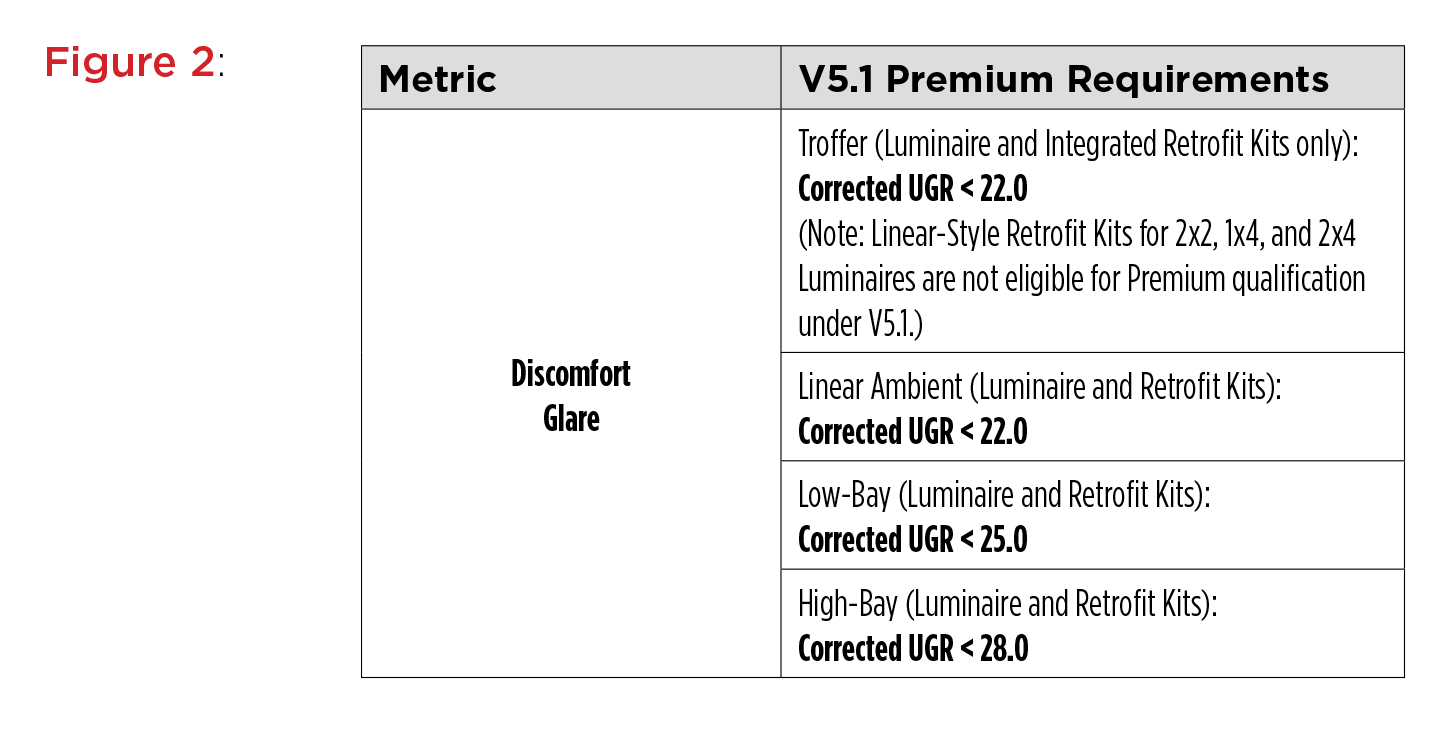1. What is UGR?
Unified Glare Rating (UGR) is a measure of potential discomfort glare experienced by an occupant in interior lighting spaces. UGR incorporates data from electric sources within an interior environment and assigns a value which represents the calculated glare rating. It only accounts for sources for which IES file data is included. It can be considered a supporting metric in addition to current IES recommendations to assess and potentially improve the quality of lighting for interior spaces.
2. What is the Unified Glare Rating System
The Unified Glare Rating System (UGR) was introduced in 1995 by the International Commission on Illumination (CIE)1 to quantify the degree of discomfort people feel from glare in environments with artificial lighting. The UGR scale ranges from 10 to 30, with higher values indicating greater discomfort. A UGR of 19 is considered the upper limit of acceptable discomfort glare according to Hopkinson’s ratings scale, a hierarchy developed in the 20th century to describe glare levels.
3. Why is UGR important?
Bright light sources with high-angle glare can cause headaches, fatigue, and other physiological issues due to constant eye adjustment. Considering the Unified Glare Rating (UGR) during product selection and application design can help reduce glare’s negative effects and improve lighting quality. However, UGR should not be the sole factor in evaluating glare; reviewing samples and considering the fixture in context are also important.
4. Where did UGR originate from and what are the primary certifications that reference it?
The International Commission on Illumination (CIE) Technical Committee 3-13 developed the Unified Glare Rating (UGR) in CIE 117-1995, aiming to quantify glare for interior lighting and its impact on occupants. CIE 190:20102 further refined this by providing guidelines for creating UGR tables for luminaires. UGR has become a standard in Europe and beyond, now also appearing in lighting specifications in the United States.
The DesignLights Consortium® (DLC®) incorporated UGR into its Solid State Lighting Technical Requirements Version 5.14, making it a requirement for various indoor product categories to receive DLC® Premium classification3. The International WELL Building Institute™ (IWBI™) includes UGR ratings in both WELL v1™ and WELL v2™ points
systems4.
The Illuminating Engineering Society (IES) references UGR in publications such as ANSI/IES RP-7-17 for lighting industrial facilities5.
5. What is included in the formula for calculating UGR?
The formula for calculating UGR is as follows:

6. How is UGR calculated?
There are 2 methods to calculate UGR:
-
Application Based UGR:
Generate a normal lighting design of the space with known fixture quantity, mounting heights, reflectances and appropriate lighting levels. Place individual observers in key locations of a building or an entire “grid” of observers in a space that will show the UGR measurement at each observer location. This is the ideal method for evaluating UGR compliance since it is based on actual room geometry, reflectances, and luminaire positions.
-
Luminaire Based UGR (also known as tabular method):
In this method a single luminaire IES file is used to produce a UGR table per CIE standards. The calculation is based on luminaires spaced on a 1×1 grid and from 2 observer locations at 1.2m above the floor and located as per Figure 1 below (CIE 117-1995). The resulting table consists of 190 values categorized by rectangular room proportions and room reflectance combinations. By cross referencing room dimensions and reflectance values in this table, UGR can be estimated considering endwise and crosswise view of the fixtures. If a single value is to be used, per CIE 117-1995, the largest value in the table must be used.
This UGR calculation method is popular because it is based solely on luminaire characteristics within a prescribed set or application variables. Luminaire specification sheets that show a single number or grid of numbers are assumed to be using this method and being reported as per CIE 117-1995 recommendations. Currently, this method is acknowledged by DLC, WELL Building Standards and LEED certifications. While this method provides a range of values and references for luminaire comparison, these values represent a generalized assessment. UGR varies by a luminaire’s lumen output, color temperature, lens options, finish, and lighting distribution. Do not assume that a single number is representative of all luminaire configurations.


7. What are common approaches to reduce discomfort glare and improve UGR score?
- Use luminaires with lower lumen packages.
- Consider tighter fixture spacings to achieve light levels needed with less brightness per fixture.
- Choose luminaires with larger luminous surfaces like 2’x4’ products vs a 1’x 4’ or 2’x 2’.
- Use products with lower candela at angles of 60 degrees and higher compared to volumetric distributions.
- For small aperture luminaires (downlights), choose optics that are well-shielded.
- Choose higher room surface reflectances to increase background luminance.
- When possible, promote higher ceilings and thus higher luminaire positioning.
- International Commission on Illumination. CIE 117-1995, Technical Report: Discomfort Glare in Interior Lighting, Vienna, Austria 1995.
- International Commission on Illumination. CIE 190 :2010, Technical Report: Calculation and Presentation of Unified Glare Rating Tables for Indoor Lighting Luminaires, 2010.
- DesignLights Consortium. DLC SSL Technical Requirements Version 5.1, 2020.
- International WELL Building Institute pbc. The WELL Building Standard version 2 pilot (WELL v2), Q3 2019. Feature L04: Glare Control.
- Illuminating Engineering society. ANSI/IES RP-7-17, Recommended Practice for Lighting Industrial Facilities, 2017.
DesignLights Consortium and DLC are a registered trademarks of the DesignLights Consortium, registered in the United States, Europe, Canada, China, and Mexico.
WELL Building Institute, IWBI, WELL v1 and WELL v2 are trademarks of the International WELL Building Institute pbc, registered in the United States and other countries.
Other trademarks and trade names are those of their respective owners.
